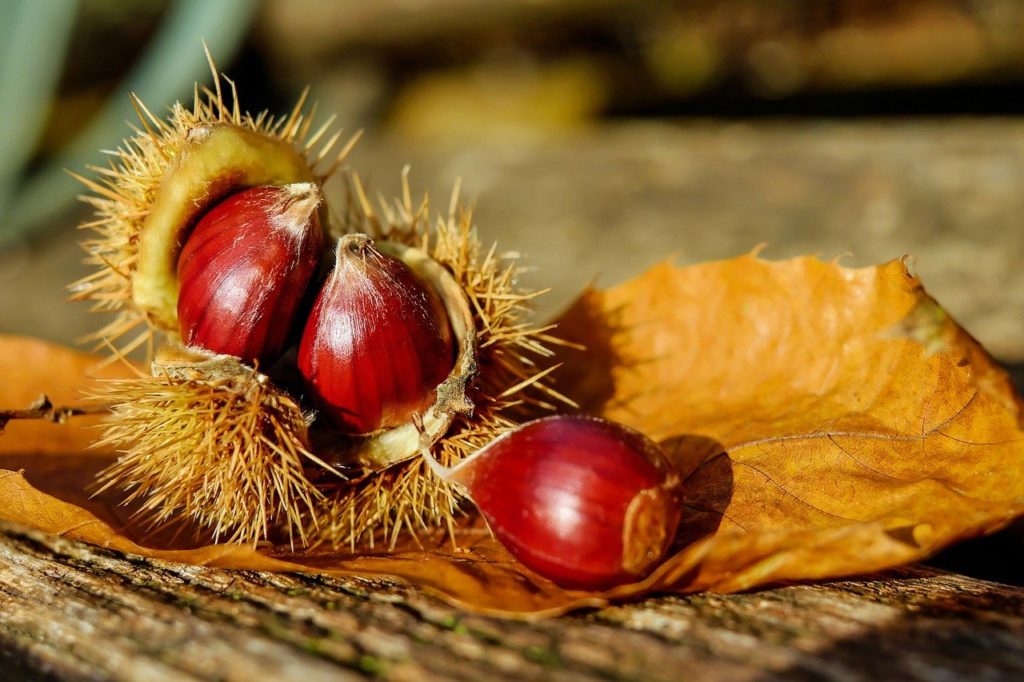
“Marrone” from Mugello: such a tasty specialty!

October in Tuscanyis the time of the chestnut harvest: in Mugello in particular there is a type of chestnut different from the others, the Marrone. Discover its history and its properties!
Characteristics of “Marrone” from Mugello
The “Marrone”, unlike the chestnut that is harvested wild in the woods, is obtained from a cultivated tree: to characterize it are the larger size and the sweeter white pulp, it is easy to peel and is not particularly floury or astringent. It has a vivacity of hazelnut, vanilla and almond, with a slight aroma of fresh bread.
History and Cultivation of “Marrone”
The cultivation of Marrone in Mugello has been known since the times of the Roman Empire but it is only since the Middle Ages that we have certain news of its spread in this area and of the importance it assumed in nutrition. In fact, it was an important economic resource and was called the “Tree of Bread” due to its frequent consumption by the farmers.
However, in the early twentieth century there was a serious crisis, caused by two diseases, which hit the chestnut trees, forcing companies to cancel production.
Only in the eighties, thanks to a renewed interest, this culture was resumed, safeguarding the chestnut trees and resuming their processing.
Cultivation takes place mainly in the municipalities of Marradi, Palazzuolo sul Senio and Dicomano but also affects parts of Borgo San Lorenzo, Firenzuola, Londa, Rufina, San Godenzo, Scarperia and Vicchio: the trees are grown naturally without the addition of pesticides or chemical additives. .
The harvest, done by hand, takes place between October and November: part of the chestnuts is sold, part is dried to be stored or used to produce flour.
Marrone from Mugello:IGP denomination
The Marrone from Mugello has the protected geographical indication trademark, better known with the acronym IGP. This label is attributed by the European Union to those agricultural and food products for which a certain quality or specific features depend on the geographical origin, and whose production, processing and / or processing takes place in a specific geographical area.
The Good Marrone from Marradi
Marradi is the home of the “Good Marrone”: there are numerous hillsides covered with chestnut trees which, like well-kept gardens, interrupt the uniformity of the spontaneous vegetation.
The love for this plant and the desire to create a project that represented it in all its aspects gave birth to the “Marrone Road”: a consortium of companies, based in Marradi, which offers the possibility of a real and its own journey to discover Marrone and its territory.
In fact, in this location, visits to the chestnut woods or inside the farms are organized to see how chestnuts are processed, as well as real tastings while the Documentation Center on Chestnut Growing was born to learn about their history.
We also recommend a visit to the local craft shops that sell beautiful objects carved in chestnut wood!
We are waiting for you in Mugello to taste the chestnuts
If you love good food, you cannot miss the numerous Mugello festivals that take place between October and November, where you can taste the famous Marroni’s cake or the marrons glace. If you want to discover the taste of Marroni chestnuts, we are waiting for you at Villa Campestri Olive Oil Resort!
Quick Booking snippet
Tuscany, an Italian region renowned for its cultural and historical wealth, is home to numerous UNESCO World Heritage Sites. These sites represent not just the architectural and artistic beauty of the region but also its significant historical heritage.
Italian cuisine, celebrated globally, is a mosaic of flavors and traditions. From the rolling hills of Tuscany to the bustling streets of Naples, each region contributes its unique essence to what we recognize as Italian cuisine. This culinary journey explores how history, culture, and regional diversity have shaped the renowned gastronomy of Italy.
Tuscany is world-renowned for its rich winemaking tradition, a heritage rooted in centuries of history and culture. In this detailed guide, which is like a true oenological journey, we will discover not only the fine wines of the region but also the traditions and landscapes that make Tuscany an unmissable destination for wine lovers.
In the heart of Italy, Tuscany stands out as one of the most emblematic regions for wine production. Famous for its landscape of gentle hills, cypress trees, and picturesque villages, this region is also a paradise for wine lovers. Tuscan vineyards, nourished by fertile soil and an ideal climate, produce wines that are appreciated worldwide […]
For those looking for a firsthand experience, the Agricultural Tourism Company Badia di Susinana offers horseback rides and trekking and riding courses with a guide, in addition to hospitality for horses and riders, located in Palazzuolo sul Senio. Alternatively, the Farm I Cavalli del Vento allows crossing beech forests and vast chestnut groves, with rides […]
Sport fishing in Tuscany offers a wide range of opportunities due to the abundance of inland and coastal waters in the region. Specifically, the province of Pistoia, with Lake Nievole in Serravalle Pistoiese, is renowned for trout fishing and other fish such as carp, grass carp, tench, and sturgeon, with a catch and release rule. […]
In Val di Chiana, to savor an authentic Chianina steak, there are several renowned restaurant options: 1. Ristorante Casa Cecco: Offers the chance to taste a Chianina steak in a farmhouse dating back to 1600. 2. Agriturismo di Trequanda: Here, Chianina meat, raised in local pastures and processed by the company’s trusted butcher shop, becomes […]
The Italian Quattrocento was a period of extraordinary artistic effervescence that produced numerous world-renowned artists. Among them, some of the most influential were: 1. Andrea Mantegna (1431–1506): A painter and engraver from Padua, famous for his frescoes in the Camera degli Sposi in Mantua.
